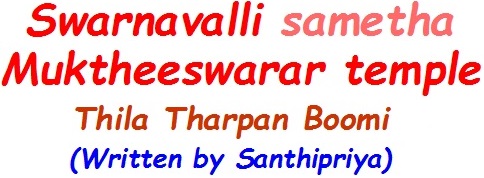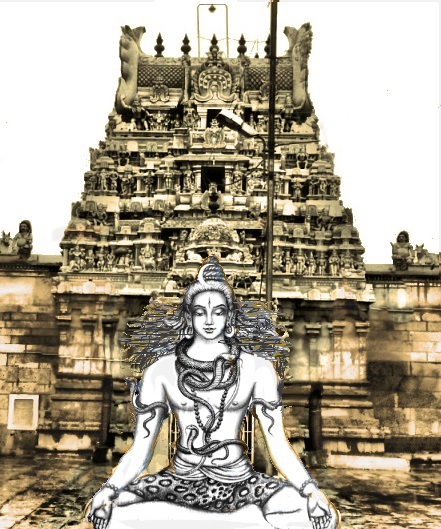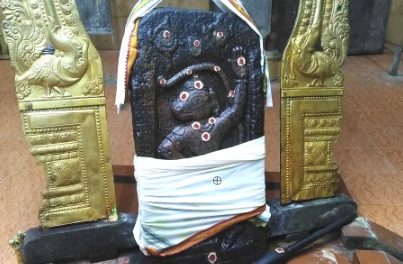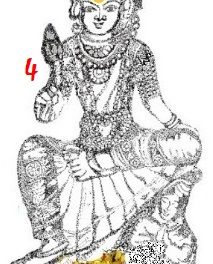

Once upon a time two rivers namely Hari-Shiva were running few Kilometers away from Koothanoor in Tamilnadu where famous Goddess Saraswathi temple exists. We know the story of Goddess Parvathi who committed suicide by falling into the Yagna fire when her husband Lord Shiva was insulted by her father Dakshaprajapathi. Even though she was Goddess and committed suicide by falling into sacred fire of Yagna, her lifeless corpse was carried like human by Lord Shiva, but since divine are not subjected to rituals like funeral and tharpan as was done to humans on earth, nothing was done thereafter till her body was cut to pieces on way by Lord Vishnu to appease the anger of Lord Shiva. The parts of the corpse fell in different places in universe. Normally when the divine incarnate end their life their bodies disappeared instantly or got buried deep inside the earth whenever the incarnation comes to an end and turn into rock images which were several centuries later dug out by humans to construct temples of worship there. However even divine incarnations born as human had to purify their souls for they shed the human body where they stayed till then. The distinction between a God in heaven and a human on earth is the distinction between the mystic ridden pure soul and the sin decayed human body. Therefore unless divine soul that shed the human body purify themselves with certain rituals, they cannot get back the divine form or their inherent powers again as souls had remained attached to the human body where it stayed so long. This is the divine rule of Paramathman who created the universe. When Goddess Parvathi committed suicide by jumping into the fire her soul shed the human body and therefore it became obligatory to get herself purified to absorb back the divine energy exclusive to her that got separated from the body when she jumped into the fire.
Against this background Goddess Parvathi came down to Thila Tharpan Boomi to get her soul purified while Lord Shiva was in penance in the same dense forest on the side of Hari-Siva Rivers to cool down his temper after the occurrence of several events when he was insulted by his father in law resulting in the death of Parvathi. Lord Shiva too preferred to descend in the site of Thila Tharpan Boomi (It did not get the status of Thila Tharpan Boomi at that time) which was then a dense forest. But both Lord Shiva and Goddess Parvathi were not aware that they both have landed in the same forest. Mother Ganges who flew from the crest of the Lord desired not to disturb the penance of the Lord and therefore she came down from his crest and converted herself into a small tributary river named Hari-Siva to convert the surrounding similar to the chill atmosphere that prevailed in Mount Himalayas to give comfort to Lord Shiva. But the two tributary rivers of Ganges disappeared later when Lord Shiva’s penance ended and ran underground in the same area underneath Thila Tharpan Boomi in invisible form and therefore it is believed that any one performing Srartha ceremony in Thila Tharpan Boomi would derive the same benefits like the one performed on the banks of river Ganges in Varanasi. There are seven sacred sites where the Srartha ceremony and tharpan when performed will relieve the sins of the souls of those dead ancestors. The seven maha sacred shethra are Kasi, Rameswaram, Sri Vanjiyam, Thiruvengadu, Thila tharpana boomi, Gaya and Allahabad .
Thila Tharpan means performing tharpan with sesame seed mixed with water and pouring it in the rivers, water tanks or water beds praying that the thirst and hunger of their dead ancestors be relieved. Thil means sesame seeds. Tharpan is a Hindu ritual performed with chanting of sacred mantras in which pouring sesame seeds mixed with water form a part of the ritual.
When Goddess Parvathi descended on earth and reached Thila Tharpan boomi, she was faced with mental agony and anxiety on the main issue of rejoining with Lord Shiva after purifying her soul. She was fully aware that first she has to to purify her soul because she had committed suicide by jumping into the fire and her body (corpse) did not vanish or disappear like any other divine manifestations when they were born as humans and ended their life span on earth. After deliberating all aspects in mind, she finally decided to perform self Tharpan to purify her soul and performed the rituals by own self.
The interesting aspect of srartha and tharpan ceremony connected to this story need to be explained here. The first aspect is that in none of the mythological stories there is mention that divine manifestations have committed suicide and the dead corpse of the manifestations have been carried like the humans on earth except the self inflicted suicide of Goddess Parvathi. The dead corpse of Goddess Parvathi was carried on the shoulders by Lord Shiva who travelled around universe in anger till Lord Vishnu cut the corpse to pieces to calm down the anger of Lord Shiva. No other incarnations have ever undergone such uniqueness.
Even in Ramayana it is mentioned that Lord Ram directed Goddess Sita to prove her modesty by jumping into the fire. Once she complied his orders she was not burnt in fire but mother earth created a crater on her body and absorbed Sita into her thus ending the incarnation of Sita.
When Lord Krishna was hit by the arrow of a hunter, he fell dead but his human body disappeared instantly. Lord Parasurama, Lord Ram and Lashman have all disappeared into the sea. Renuka Devi, mother of Lord Parasurama too disappeared when she was traveling with Parasurama. Similarly on earth Adi Sankara who was divine incarnate of Lord Shiva disappeared in Himalayas. Their bodies have never been seen. Thus Goddess Parvathi has been the only known unique exception wherein upon her death, her corpse was carried by the Lord on his shoulders very similar to the decedents of those dead on earth carrying the dead bodies on their shoulders for funeral rites. Moreover several parts of her corpse reportedly fell in different places on earth to become Sakthi temples. Therefore it became inevitable for Goddess Parvathi to undergo the ritual of tharpan in earth to cleanse her soul departed from the human body which turned into a corpse.
The second aspect is regarding self tharpan performed by Goddess Parvathi. What she performed was not similar tharpan or ritual connected to it as done by humans, but divine tharpan meant only to cleanse her soul to absorb back the divine energies exclusive to Goddess Parvathi. The similarities was only the use of essential ingredients needed for the ritual which is sesame seed and water. Unless the soul is cleansed and purified by performing certain process similar to tharpan performed by humans when sesame seed mixed with water is offered to free the souls from sins, her divine energies floated in cosmic and traveled along with her soul but unattached to soul needed to be absorbed back into the soul by divine tharpan by sitting on a wet sesame seed bed and chant certain mantras exclusive to divine unknown to humans.
Therefore she took bath in river Hari-Siva, sat on a fully wet ground spread thickly with sesame seed and chanted certain mantras exclusive to Goddess Parvathi to direct her divine energy floated in cosmic to enter into her body through the soul as before. Till the divine energy exclusive to her was absorbed back into her, she remained seated on the wet sesame seed spread ground. The wet sesame seeds are believed to have the power to retain or regain the divine energy and consciousness as it is divine seed. Since sesame seed and water were involved in energizing the soul by penance by the divine soul, it was considered to be a divine tharpan process.
The sacred act of self tharpan as performed by Goddess Parvathi was revealed by Sage Vashishta to Rama and Lakhman before they came to Thila Tharpan Boomi. Why did Lord Ram and Lakhman come to Thila Tharpan boomi? What was the story?
At the end of Lankan war Lord Ram and Lashman returned to Ayodhya. On way both of them performed Srartha ritual to Dasaratha at Rameswaram. Prior to war too they had performed tharpan ritual and gave Pinda daan to Dasaratha when they were in exile in the forest when Dasaratha’s death news was received. However even after the tharpan they could not derive mental peace and some sort of uneasiness haunted their mind and heart because the Pinda daan offered were not accepted by the crows indicating that the ritual may have remained incomplete. The felt that they were not rid of Brahmathi dosha and perhaps it continued to haunt them. Therefore when they sought the counsel of sage Vashishta he shared another sacred information as revealed by sage Narada Muni to him. The said secret was revealed by mother Ganga to Narada Muni. What was the sacred information?
‘While Lord Shiva was in penance in Thila Tharpan Boomi, Narada Muni once happened to pass by the side of the said forest and was surprised to see mother Ganges flowing there as tributary river and quickly came down to inquire her of the reason. In the midst of their talk, river Ganges told Narada Muni that in Thila Tharpan boomi, she noticed large no of people living in and around the area came there throughout the year, even at odd hours and performed tharpan and offered Pinda daan to the departed souls of their ancestors after taking bath in her water (then flown as tributary river in the name of Hari-Siva). The pinda daan in the form of rice balls offered by them were taken directly by the invisible dead souls and Lord Brahma in invisible form (Antharyathmi) sitting at a distance near present Koothanoor where Goddess Saraswathi temple exists, noted something in silence without disturbing the penance of Lord Shiva. Mother Ganges was thrilled to notice that in each one of the cases the dead souls of the ancestors in invisible form personally came there and accepted the pinda rice balls* from her river bank unhindered by Yama Ganas whose presence were nowhere seen there. But she too could not explain to Narada Muni the rationale behind the absence of the Yama ganas under whose custody the dead souls remain. (*The rice balls were not physically taken by the invisible souls but due to the sacredness of the mantras chanted by the pundits several times more quantity of pinda as offered in earth were given to the dead souls by Yama ganas. This is the rule of Paramathman and even Yama or his Ganas cannot defy the rule. Crow being Lord Yama’s carrier vehicle, Yama ganas direct the crows in earth to physically eat the rice balls to indicate to humans that the pinda has been accepted by the concerned souls in heavenly abodes).
Sage Narada was thrilled to hear the information and unable to resist his temptation to know why Yama or his ganas accompany the souls, he decided to wait in Thila Tharpan Boomi till Lord Shiva opened his eyes to seek the reason for the surprising event happening there. Once Lord Shiva’s penance ended he rushed to him to pay his obeisance and prayers and sought clarity on this mystic issue of the departed souls directly coming and accepting the Pinda daan without hindrance from Yama ganas.
Lord Shiva told him that whichever place he (Lord Shiva) sat in penance, they were out of bounds to Lord Yama or his bhootha ganas for ever and they were not empowered to even cause slightest disturbance to any souls visiting there. Therefore the tharpan performed in Thila Tharpan Boomi was highest in sacredness as the Ganges flowing from his crest flew through his legs as tributary river to give soothing of chillness during his penance and thus the Ganges further got sanctified by this act. Once his penance ended, Ganges went back into his crest and the tributary rivers of her hid below earth and ran underground thus turning the area into highly sanctified one and unreachable to Lord Yama and his deva ganas. Therefore the Pinda daan given in Thila Tharpan Boomi goes to the departed souls directly and the sins arising out of non compliance of tharpan gets wiped off. Further this was the only place on earth the tharpan can be performed on any day of the year without referring the almanac since both Lord Chandra and Lord Sun daily visit Thila Tharpan Boomi together to offer their reverence and prayer to Lord Shiva. When both Lord Chandra and Lord Sun stay together the day is called Amavasya day- full dark sky. Due to this reason all through the year it is Amavasya day in Muktheeswar temple in Thila Tharpan Boomi and therefore the tharpan can be performed at any time on any day (Why both of them visited earth together by the cunning act of Lord Krishna is narrated in Mahabharata). On realizing the merit of the sacredness of the place his consort Parvathi too chose to perform self tharpan to get her purified. That was the sole reason why Thila Tharpan Boomi was the only place on earth where when the departed souls were given Pinda daan after performing tharpan were directly accepted by the departed souls and went to Shivaloga directly from there without facing further persecution at the hands of Yama even if some punishment remained to be completed’.
When Lord Ram learnt of the glory of Thila Tharpan Boomi from sage Vashishta, he immediately decided that it would be the proper place to perform tharpan to his father Dasaratha and also to bird Jadayu whom he respected like his father and who died for his cause while attempting to stop Ravan who forceably carried Sita. Only after sage Vashishta unravelled the sacred story did Lord Ram realise that Bird Jadayu whom Lord Ram considered as his step father could not be accorded proper rituals either on way to Sri Lanka or in Rameswaram after Bird Jadayu died and perhaps that could be the reason for uneasiness haunting him. Now that the proper place to perform tharpan that remained insufficiently performed have been identified, Lord Ram decided to immediately proceed to Thila Tharpan Boomi and perform the rituals once again so that the departed souls rested in peace thereby offering mental peace to them (Ram and Lashman). Without waiting further, Lord Ram and Lashman proceeded to Thila Tharpan Boomi to perform the ritual and tharpan for both their father Dasaratha and father like figure Bird Jadayu at the bank of river Hari–Siva which was then flowing near the place where Lord Shiva performed penance. Before commencing tharpan and Srartha ceremony, Lord Ram and Lashman offered worship to their mother, father, Guru and other deities. Once they placed the Pinda after performing the tharpan, the rice balls instantly turned into Shiva Lings. Next both Dasaratha and Jadayu appeared before them to inform that they were fully satisfied with the ritual and happily proceeding to swarga loga from there. Realizing the presence of Lord Shiva there Rama and Lashman performed pooja to those Shiv Lings and worshiped them. From there they proceeded to Koothanoor where Lord Brahma stayed in invisible form, worshiped him too and returned back to Ayodhya.
Many centuries later when one of the Kings who ruled Varanasi sought to know from Sage Narada whether any other place beyond Varanasi exist on earth where the thirst and hunger of the dead souls of ancestors could be satiated by performing tharpan and the departed souls attain Shivaloga prapthi (Reaching Shiva Loga directly after taking rice balls called pinda daan), the sage revealed that in earth one cannot find another sacred place equivalent to Thila Tharpan Boomi to perform tharpan as it was the most sanctified place from where the dead souls of the ancestors directly go to Shiva Loga without fear of Yama after taking pinda daan there since it was the sacred place where Lord Shiva penanced, Goddess Parvathi performed self tharpan, Lord Ram and Lashman performed tharpan to their father Dasaratha and father like figure Bird Jadayu and to be blessed to see the Pinda offered by them turn into Shiva Lings thereby indicating that it was Shiva Boomi where Yama or his ganas cannot enter and deter the departed souls from accepting pinda to satiate their hunger and thirst. The Shiva Lings found consecrated on the backyard of the temple are believed to be the same Shiva Lings worshiped by Lord Ram and Lashman after performing tharpan on the river banks of River Hari-Siva.
A river called Arasalur flowing from north to Southern side near Thila Tharpan Boomi, is believed to be the very same Hari-Siva tributary river of mother Ganges flowing in Varanasi. Therefore it is firmly believed that those who could not perform annual tharpan to the departed ancestors in their lifetime for any reason, if they come to Thila Tharpan Boomi and perform Srartha ceremony and other rituals including pinda daan in memory of those dead in their family, the departed souls will rest in peace for ever and the families of those who perform the tharpan will also be rid of the sins arising out of non performance of the rituals till then and be blessed with mental peace and happiness.
The 2000 year old Shiva temple is called Muktheeswar temple and Lord Shiva manifest here as Muktheeswar and grace the souls to go to Shiva Log after they visit there and accept the Pinda daan. Since both Lord Chandra and Lord Sun daily visit the temple site to worship Lord Shiva, every day is considered to be Amavasya day in the temple site and therefore any one can visit the temple on any day to perform tharpan without referring to almanac.
The pundit in the temple claimed that not only to ancestors but also if the tharpan is performed here for both known and unknown friends, their souls will also be freed from sins, but will also go to Shiva loga and rest in peace. This temple is situated nearly two kilometers away from Koothanoor on way to Mayavaram.
Temple for Adi Vinayaga
with human face

Adi Vinayaga in temple with human face
As narrated earlier Goddess Parvathi came to Thila Tharpan Boomi which was then a dense forest to get back her divine energies which had earlier got released from her soul during the course of self inflicted suicide. She took bath in Hari-Siva River and performed self tharpan and concluded the ritual before sitting in penance. Penance once concluded, she was freed of her sins and absorbed back her divine energies. Her next act was to reunite with the Lord as his consort Goddess Parvathi. Thereafter she planted a Mandara tree (Maloo Creeper) near the spot where Lord Shiva had earlier penanced, took bath in a temporarily thatch covered from all sides made of leaf of Palmyra and coconut trees after keeping her son Vinayaga, who was then with human face hidden in a turmeric ball as security guard some distance away from the thatched hut so that no one reach the bathing shed when she was bathing. Lord Vinayaga had been strictly instructed not to allow anyone step even an inch inside the boundary of bathing site. After taking bath she would remain on penance seeking reunion with her Lord. Several years thus passed.
In the meanwhile Lord Shiva who had earlier completed his penance returned to Shiva Log and finding his consort Parvathi not seen, he began searching for his consort all over heaven and came to know that she was in the same place (Thila Tharpan Boomi) where he concluded his penance. Therefore he rushed to the site and calling her name ran towards the shed in which she was taking bath. Lord Vinayaga guarding the site rose up and stopped his father entering the bathing site as he had been instructed not to allow any one enter into the boundary even if the visitor was his own father.
Angered by the act of his son Vinayaga, Lord Shiva quickly cut off his head and in the commotion Goddess Parvathi came out rushing to see her son’s headless body lying on ground. While the headless body of Lord Ganesha was lying on the southern side, the head was found pulsating on the northern side. She fell onto the feet of her Lord and sought mercy to bring back to life her son Vinayaga lying on ground headless. Lord Shiva too realized his mistake and asked his ganas to quickly search if any headless body was lying on northern side. At the first sight whatever was found the head should be immediately brought there. The deva ganas of Lord Shiva dispersed in search of headless body and could find only the head of an elephant at first sight and therefore they brought elephant head to their master. On receiving the elephant head Lord Shiva placed it over the lifeless body of Vinayaga and instantly Vinayaga got up elephant headed which thus became his permanent form.
He was warmly hugged by the parents and Lord Shiva who blessed their son that henceforth Vinayaga would manifest there in the name of Adi Vinayaga (Ancient Vinayaga in human face) but with human face and continue to bless the devotees who would come there seeking the grace of Muktheeswar. The spot where both Lord Shiva and his consort Parvathi penanced would turn into a place of worship. Lord Shiva would manifest as Muktheeswarar and Parvathi as Swarnavalli. Unless blessings of human faced Adi Vinayaga seated a distance away from the temple is taken the devotees would not be blessed either by Lord Muktheeswarar or Goddess Swarnavalli. Thus Thila Tharpan Boomi has gained highest order of prominence amongst all other places of worship in the southern side.



